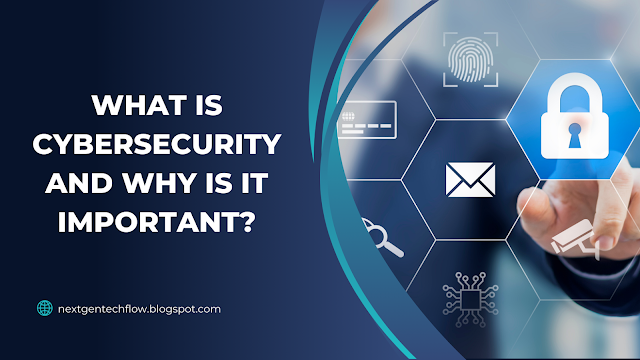
|
| What is Cybersecurity and Why is it Important? |
Table of Contents
In today’s interconnected world, cybersecurity has become a critical concern for individuals, businesses, and governments alike. With the ever-growing dependence on digital systems, protecting sensitive information and maintaining trust in online platforms is no longer optional—it’s essential.
Understanding Cybersecurity
Definition of Cybersecurity
Cybersecurity refers to the practice of safeguarding systems, networks, and data from cyber threats, including unauthorized access, attacks, damage, or theft. It encompasses a wide array of technologies, processes, and measures designed to combat both internal and external threats.
Key Components of Cybersecurity
- Network Security: Protecting networks from intrusions or attacks.
- Application Security: Ensuring software and apps are resistant to vulnerabilities.
- Information Security: Safeguarding data integrity and confidentiality.
- Operational Security: Securing processes that involve handling data and digital systems.
- Disaster Recovery and Business Continuity: Developing plans to restore systems after breaches or disasters.
Why is Cybersecurity Important?
Protecting Sensitive Data
Cybersecurity ensures the confidentiality of personal, financial, and business information. From bank account details to proprietary corporate strategies, safeguarding data prevents exploitation by malicious actors.
Preventing Financial Loss
Cyberattacks, such as ransomware or phishing schemes, can lead to significant financial setbacks. By employing robust cybersecurity measures, businesses mitigate the risk of economic damage.
Maintaining Reputation and Trust
Organizations that prioritize cybersecurity maintain customer trust. A data breach can tarnish a company’s image, leading to loss of customers and long-term credibility issues.
Ensuring Compliance with Regulations
Governments worldwide have established strict data protection laws, such as GDPR and HIPAA. Failing to comply can result in hefty fines and legal repercussions.
Common Types of Cyber Threats
1. Malware
Malicious software like viruses, worms, and spyware infiltrates systems, often causing irreversible damage.
2. Phishing
Deceptive emails or messages trick individuals into revealing sensitive information, such as passwords or credit card numbers.
3. Ransomware
This type of malware locks users out of their systems, demanding payment for access restoration.
4. Denial-of-Service (DoS) Attacks
Flooding servers with traffic, DoS attacks disrupt legitimate access to online services.
5. Insider Threats
Employees or contractors with access to sensitive systems can intentionally or accidentally compromise security.
6. Advanced Persistent Threats (APTs)
Sophisticated, prolonged cyberattacks target specific organizations to extract valuable information.
How to Strengthen Cybersecurity
1. Use Strong Passwords
Employ complex passwords with a mix of letters, numbers, and symbols. Avoid reusing passwords across multiple platforms.
2. Implement Multi-Factor Authentication (MFA)
Adding an extra layer of security ensures that unauthorized users cannot access systems even if passwords are compromised.
3. Regular Software Updates
Keeping systems and applications updated eliminates vulnerabilities that hackers exploit.
4. Employee Training
Educating employees on recognizing phishing emails and practicing secure online habits reduces human-related vulnerabilities.
5. Invest in Security Tools
Firewalls, antivirus software, and intrusion detection systems form the backbone of cybersecurity measures.
6. Back Up Data Regularly
Frequent backups ensure critical data is retrievable in case of breaches or ransomware attacks.
The Role of Cybersecurity in Business
Protecting Intellectual Property
Businesses rely on cybersecurity to protect their unique innovations, designs, and processes from competitors and cybercriminals.
Securing Remote Work
With the rise of remote working, organizations need to ensure secure connections through VPNs and encrypted communication tools.
Detecting and Responding to Incidents
Modern businesses use security operation centers (SOCs) to monitor and address threats proactively, minimizing downtime and losses.
Emerging Trends in Cybersecurity
1. Artificial Intelligence (AI) and Machine Learning
AI-driven tools enhance threat detection, analyzing vast datasets to predict and prevent attacks in real-time.
2. Zero Trust Architecture
Adopting a “never trust, always verify” approach strengthens defenses, even for internal traffic.
3. Cloud Security
As businesses migrate to cloud-based platforms, ensuring the security of cloud environments becomes paramount.
4. Internet of Things (IoT) Security
The proliferation of connected devices necessitates robust measures to prevent vulnerabilities in IoT ecosystems.
Consequences of Ignoring Cybersecurity
Organizations that neglect cybersecurity face dire consequences:
- Financial Penalties: Breaches can result in massive fines and legal battles.
- Data Loss: Losing critical data can halt operations.
- Reputation Damage: A single incident can erode public trust for years.
- Operational Downtime: Recovery from attacks often involves prolonged periods of inactivity.
Frequently Asked Questions (FAQs)
1. What are the main objectives of cybersecurity?
Cybersecurity aims to protect confidentiality, integrity, and availability of data while preventing unauthorized access and threats.
2. How can individuals protect themselves online?
Individuals should use strong passwords, enable two-factor authentication, and remain cautious of phishing attempts.
3. What industries are most targeted by cyberattacks?
Healthcare, finance, retail, and government sectors are frequent targets due to the sensitive nature of their data.
4. Can small businesses afford cybersecurity?
Yes, small businesses can adopt cost-effective measures like cloud-based security services and regular employee training.
5. What is the future of cybersecurity?
The future involves integrating AI, advanced encryption methods, and global cooperation to combat increasingly sophisticated cyber threats.
Cybersecurity is an indispensable component of modern life, safeguarding not only individual data but also the integrity of businesses and national infrastructures. As threats evolve, investing in robust cybersecurity measures ensures resilience against breaches, protects sensitive information, and maintains public trust. By prioritizing proactive defense strategies, we can secure the digital world for future generations.

